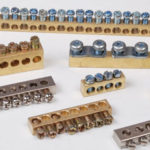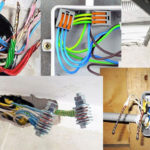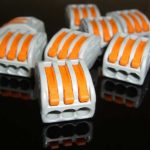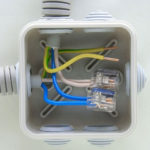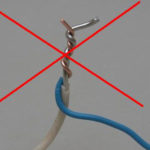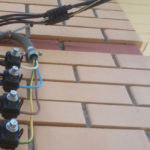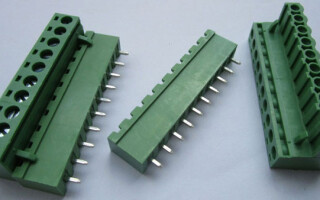Achieving sure contact when connecting electrical wires is a task that the terminal block helps to solve. There are different designs of such electrical equipment, but they are all designed to ensure the reliability and safety of wiring at the joints.
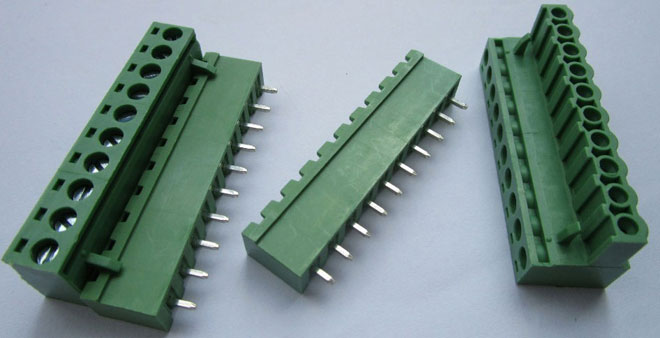
Contents
Principle of connection of wires
Connection of wires is regulated by the Electrical Installations Code. According to them, the simple stranding used most often is considered a violation and must be supplemented by soldering, welding or crimping.
At home, a safe and reliable replacement for soldered joints are crimp terminals of various types. Even a non-professional electrician can switch wires in a junction box or extend a short cable. The principle by which terminal blocks work is to crimp each end of the connected conductor with a common part of the structure (sleeve, spring, pressure plate, etc.). Metal (steel, brass) does not form an electrochemical pair with copper and aluminum, and the connection lasts longer. The plastic body serves as an insulator for the ends to be connected.
The contact area in this case is sufficient to ensure the full passage of current. The main advantage provided by the terminal block for connecting wires is the possibility of switching dissimilar cables. With this design you can well join aluminum and copper, solid and stranded conductors. Connecting elements are also convenient for conducting a separate circuit from the common line, if you want to switch from a conductor with a large cross section to a thinner one.
Depending on the type of design, the blocks can be mounted on a wall or on a panelboard (terminal blocks for DIN-rail) or free to be placed in a junction box.
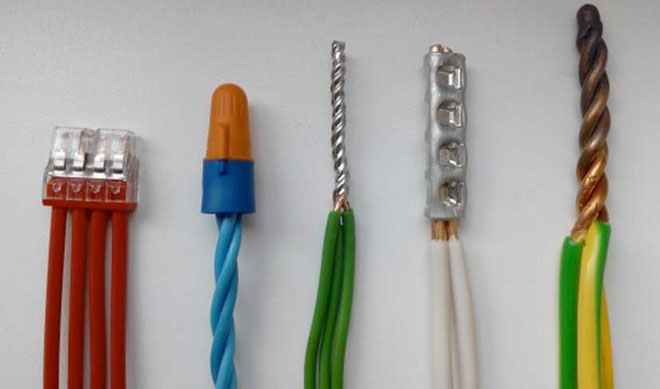
Types of terminal blocks
Regardless of the material from which the body is made and the possibility of rigid mounting on the site of installation, terminal connection blocks are divided into 2 large types:
- screw;
- spring-loaded.
This division refers to the way in which the ends of the spliced conductors are fastened.
Screwed .
This type is the most common due to its cheapness and ease of installation. The design of a screw pad includes a sleeve for the wire and a clamping screw. Some models are equipped with a clamping plate that keeps the end of the conductor secure during installation.
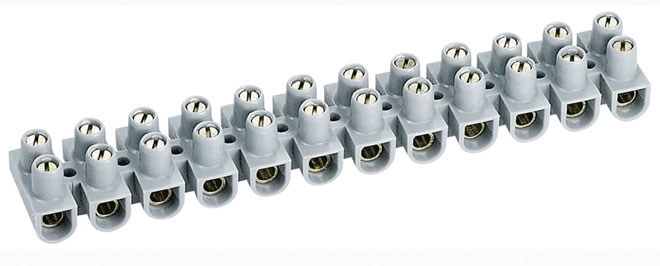
Some screw terminal blocks have 2 inlets where the ends of the wires that need to be connected are placed. There are also models with 1 inlet where both ends to be connected are inserted. In both cases, a special clamping screw is required to ensure contact between the sleeve and the cables to be connected. This part either presses directly on the wire placed in the sleeve or moves a metal plate that presses it into the sleeve socket. The sleeve has a semi-circular cross-section. This helps create a larger surface area for contact with the conductor.
When selecting a screw pad for wiring your home, keep in mind that plate-less screw clamps are more commonly used to connect 1-wire wires. When splicing multicore ends, the edges of the screw often damage the thin wire. But a screw clamp with a pressure plate is convenient for working with such wires as well.
If you need to connect cables with different wire thicknesses, you should choose a model with separate inputs. Manufacturers of electrical equipment produce terminal blocks of different sizes, and the home handyman needs to choose the most appropriate block. It is worth bearing in mind that a strong mismatch in the diameter of the sleeve and the wire will not allow the strand to be pressed firmly.
The result of such a poor-quality connection will be rapid oxidation of the contacting surfaces and their heating. If necessary, too thin stripped core can be folded in half and twisted to increase its diameter.
Installation of screw models is quite simple:
- Prepare a knife and slotted screwdriver.
- Remove the insulation from the end of the cables to be connected by 0.7-1 cm.
- Unscrew the screw slightly and place the stripped end into the socket so that it sinks in completely. Do not leave any part of the bare conductor outside the socket.
- Tighten the screw. To avoid damaging a stranded or soft aluminum conductor, do not overtighten the screw until it engages the wire at the bottom of the sleeve. Then turn the screw ¼-1/3 of a turn. If you are using a clamping plate sleeve, you can attach it without these precautions by tightening the threaded element until the wire is secured.
- Check that it is securely fastened by pulling on the end installed in the socket. If the screw is tightened enough and the wire is not damaged, it will not be possible to pull it out of the socket.
Models of terminal blocks with screw connection sometimes also have mounting holes located between pairs of contacts. If necessary, such a terminal block can be attached to any surface using self-tapping screws.
Spring-loaded
The fixation of the conductor in the spring-type terminal block is carried out by means of a steel spring of complex shape. The sleeve is made of tinned copper. The mechanism is enclosed in a plastic housing of a material that can withstand high temperatures (polycarbonate, polyamide, etc.). Metal parts are inside, and the housing serves as an insulator for the connection.
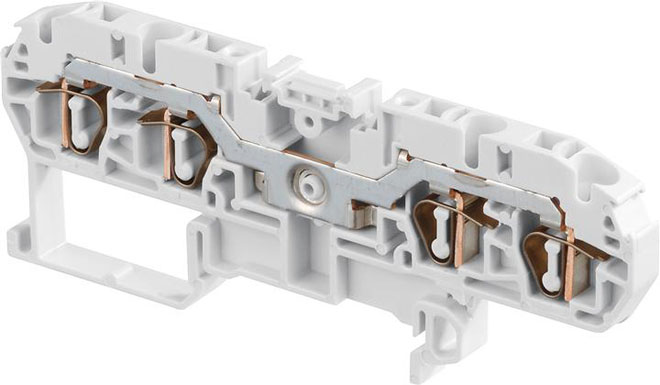
In the Russian market the most common products are made by WAGO. Manufacturers produce spring (clamp) terminal blocks of 2 varieties:
- Non-disposable, or Puch Wire. They snap into place independently after the end of the wire is inserted into the sleeve. If it is necessary to replace the terminal block if it breaks, you will have to cut the entire electrical installation and replace it with another one. These products cannot be disassembled.
- Reusable, or Cage Clamp. These models have a plastic lever that, when pressed, locks the wire in the socket, and when lifted, the end can be released.
Spring-loaded terminals have 2 to 8 sockets and are rated for a rated voltage of 220V at 32A. Dimensions of the connection products can be selected for different cables, cross section of 0.5-4 mm². Some models have a DIN-rail mount, but there are also terminals without fastening.
Wires are connected by spring-loaded terminals in the following order:
- Strip the end to be connected to a length of 1-1.3 cm.
- Open the clamp with the end of a screwdriver, insert the conductor into the clamp, and remove the screwdriver from the terminal block. The spring will click into place automatically. The reusable pad is opened by lifting the lever. It is lowered into the specially designed recess on the housing to latch the spring.
- Check reliability by pulling the cable.
When installing the connection with such pads, note that only 1 conductor should be placed in each socket.
The advantages of such a connection are that it is done quickly and reliably, does not require special knowledge and tools. To monitor the presence of voltage on the terminal block there are special holes for a probe screwdriver.
Disadvantages of pads
Clamping connection of different types has tangible disadvantages:
- Some electricians believe that spring products are not well suited for heavy loads. Mount terminal blocks are recommended for low-current circuits: lighting, economic household appliances, etc.
- Screw terminal blocks do not hold aluminum wires well. Even if the connection is done correctly, it will loosen over time. It is recommended that such electrical installations be checked once or twice a year and the screws re-tightened.
Even a good quality terminal connection is not very durable because of the oxide film that forms on the metal surfaces.
Related articles:
